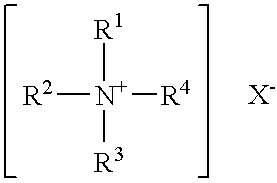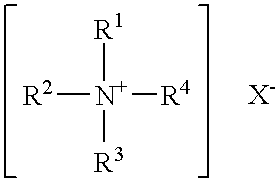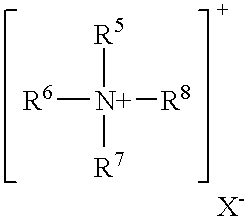Organophilic clay additives and oil well drilling fluids with less temperature dependent rheological properties
a technology of additives and clay, applied in the direction of inorganic chemistry, silicon compounds, wellbore/well accessories, etc., can solve the problems of affecting the physical properties and performance of fluids, affecting the rheological properties of fluids, and fluids and their additives involve highly complex chemical reactions, and achieve less effective rheological effects
- Summary
- Abstract
- Description
- Claims
- Application Information
AI Technical Summary
Benefits of technology
Problems solved by technology
Method used
Image
Examples
examples 1-3
[0127]
Composition SummaryEA#1133190319131923193AttapulgiteAttagelAttagelAttagelAttagelAttagelOrganic content, % of100 100 100 100 100Clay CECRatio 2M2HT: Ethoquad10075:2550:5025:750:10018 / 25
[0128] Example 1: Table 1 illustrates the effect of EA-3191 on the viscosity of an oil-based drilling mud after being subjected to 400° F. dynamic conditions. When 5.0 ppb EA-113® (used in combination with 15.0 ppb BENTONE 42®), is compared to 5.0 ppb EA-3191 (used in combination with BENTONE 42), EA-3191 demonstrated an improved temperature stability by exhibiting a higher rheology after dynamically heat aging at 400° F. The high shear rate viscosity, measured at 600 rpm is 33% greater than that of the EA-113 sample. The low shear rate viscosity, measured at 6 rpm, is also higher in the EA-3191 sample. Additionally, the Yield Point of the EA-113 (12) compared to EA-3191 (22) shows that the EA-3191 will be more effective at suspending solids.
example 1
[0129] Table 1:
TABLE 1AdditiveEA-113 / EA-3191 / BENTONE 42BENTONE 42Additive(s) Concentration5 g / 15 g5 g / 15 gHR 400° F.HR 400° F.OFI 800 Viscosity @ 120° F.120° F. Test120° F. Test600 RPM Reading84112300 RPM Reading4867200 RPM Reading3450100 RPM Reading2030 6 RPM Reading46 3 RPM Reading45Electrical StabilityApparent Visc., cPs4256Plastic Visc., cPs3645Yield Point, Lbs / 100 ft{circumflex over ( )}21222FormulationLbs / BBLIAO186 gPrimary Emulsifier 10 g30% CaCl2 Brine 75 gLime 4 gAdditive(s)See TableBarite215 g
[0130] Example 2: Table 2 illustrates the effect of high temperature (400° F.) on the viscosity of an oil-based drilling mud contaminated with rev dust to simulate drill solids (rev dust is an altered montmorillonite clay containing 15-40% cristobalite and 10-20% quartz supplied by Milwhite Inc. (CAS# 1302-78-9)
[0131] When 5.0 ppb EA-113 is combined with 15.0 ppb BENTONE 42®, and compared to 5 ppb of EA-3191 (combined with 15 ppb of BENTONE 42), EA-3191 exhibited a more stable rheo...
example 2
[0132] Table 2:
TABLE 2AdditiveEA-113 / EA-3191 / BENTONE 42BENTONE 42Additive(s) Concentration5 g / 15 g5 g / 15 gHRHRInitial400° F.Initial400° F.120° F.120° F.120° F.120° F.OFI 800 Viscosity @ 120° F.TestTestTestTest600 RPM Reading110738695300 RPM Reading72415154200 RPM Reading57303940100 RPM Reading41192526 6 RPM Reading17688 3 RPM Reading16577Electrical StabilityApparent Visc., cPs55374348Plastic Visc., cPs38323541Yield Point, Lbs / 100 ft{circumflex over ( )}23491613FormulationLbs / BBLIAO186 gPrimary 10 gEmulsifier30% CaCl2 Brine 75 gLime 4 gAdditive(s)See TableBarite215 gRev Dust 25 g
[0133] Example 3: Table 3 illustrates the effect of increasing the Ethoquad 18 / 25 (ethoxylated quaternary) concentration in the organic content of the experimental additive. As the concentration of Ethoquad 18 / 25 increases (the concentration of 2M2HT decreases) the rheological profile of an oil-based drilling mud after hot rolling for 16 hours at 400° F. increases.
PUM
| Property | Measurement | Unit |
|---|---|---|
| temperature | aaaaa | aaaaa |
| depths | aaaaa | aaaaa |
| temperature | aaaaa | aaaaa |
Abstract
Description
Claims
Application Information
 Login to View More
Login to View More - R&D
- Intellectual Property
- Life Sciences
- Materials
- Tech Scout
- Unparalleled Data Quality
- Higher Quality Content
- 60% Fewer Hallucinations
Browse by: Latest US Patents, China's latest patents, Technical Efficacy Thesaurus, Application Domain, Technology Topic, Popular Technical Reports.
© 2025 PatSnap. All rights reserved.Legal|Privacy policy|Modern Slavery Act Transparency Statement|Sitemap|About US| Contact US: help@patsnap.com



